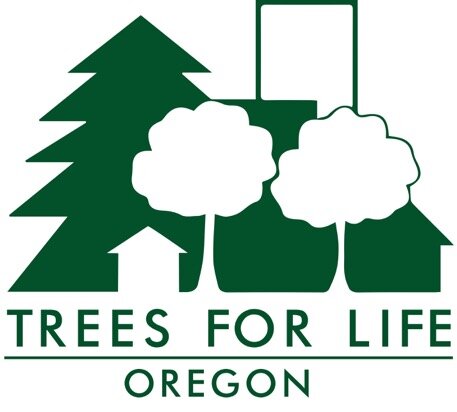St. Johns Tree Policy Walk Highlights Emerald Ash Borer’s Threat to Canopy
On June 30, Dominic Maze, with the Portland Bureau of Environmental Services, happened to notice that ash trees next to his children’s summer school in Forest Grove, Oregon, carried the tiny but distinctive D-shaped exit holes in their bark made by the emerald ash borer (EAB). His sighting, later confirmed by Oregon Department of Forestry and federal entomologists, was the first in Oregon.
Authorities had been dreading EAB’s arrival for years. Why? Because EAB kills ash trees. Females seek out ash trees in early summer, laying their eggs on the bark. When the larvae hatch, they burrow in and begin feeding under the bark. Eventually their feeding tunnels girdle the tree, killing it. All species of North American and European ash are susceptible, including Oregon’s native species, Fraxinus latifolia.
EAB likely arrived in the U.S. in the 1990s in pallets from China and was first found in Michigan in 2002. Since then, this invasive insect has wreaked havoc on that region’s ash trees, defying all efforts to eradicate it. Within a few years of arriving in a new area, EAB infests and destroys most ash trees. Mortality can exceed 99 percent of untreated trees. The pest has already killed tens of millions of ash trees in rural and urban areas across the country. The insect can fly 10 miles a year but spreads much faster by people transporting infested firewood.
Gersbach points out golden desert ash trees on N. Charleston St., near Lombard St. All photos by Kyna Rubin, TFLO.
On an Oct. 15 tree walk he led in the St. Johns neighborhood, Trees for Life Oregon’s Jim Gersbach focused on what EAB means for Portlanders and how government and residents can prepare. The event was the last in a series of five TFLO-led tree policy walks in different low-canopy areas of the city this past summer and fall.
Ashes currently represent just 4.3 percent of Portland’s street trees. However, that translates to more than 9,200 individual trees at risk. Crucially, some city blocks contain whole rows of ash trees, meaning that when the insect hits Portland (it was discovered only 26 miles west of the city), residents along these streets will likely lose most of their canopy. Portland’s natural areas will also be deeply affected because ashes can make up to 70 percent of wetland areas and streamside forests.
Early detection of EAB is challenging because canopy dieback usually starts at the top of the tree, where it often goes unnoticed. By the time evidence like the D-shaped exit holes appear at human eye level, the EAB has already been infesting the tree for three or four years, dooming it.
Portland removed ash from its list of approved street trees a few years ago, though right now the City does not have the mechanisms in place to ensure that developers don’t plant ash trees on private sites. According to a City staffer who attended the walk, Urban Forestry is now working with other City agencies to put such policies in place. Unfortunately, said Gersbach, demand for ash trees has plummeted east of the Rockies, which has lowered prices for West-Coast buyers and made ash easy bait for developers looking to economize on required trees.
Large green ash at the corner of N. Leonard St. and N. John Ave., next to James John Elementary School.
The golden desert ash (Fraxinus excelsior ‘Aureafolia’) is plentiful in Portland and highly desired for its golden fall color. “It’s fast-growing and one of the cheapest trees a developer can buy,” he said. Raywood ash (F. angustifolia ‘Raywood’), with its purple-red fall color, has also been popular here. But all ash cultivars are at risk.
What to Do?
The EAB’s arrival to Oregon underscores why it’s so vital that the City and residents plant a diversity of tree species, not only across the city but within each block. Traditional-style allées of one species of tree down a street can look striking (ashes in fall, for instance!) but single-species plantings can’t prevent canopy loss once species-specific pests and disease arrive. Also, Portland’s increasingly dry, scorching summers stress our canopy, including our native trees (e.g., Western redcedar), and stress intensifies trees’ vulnerability to threats like EAB.
A row of ashes on N. Richmond Ave. near N. Hudson St. These ashes could all be dead in the next five years.
Gersbach cites articles stating pesticide injections against EAB are about 85 to 95 percent effective. But they are expensive and need to be done every two years. Currently, the state of Oregon recommends communities identify and prioritize for treatment the ash trees that are healthy and contributing lots of canopy.
“People have to weigh how much chemical treatment they want to invest in, in order to retain the environmental and aesthetic benefits of specific ash trees,” noted Gersbach. “Treatments are most effective if begun before a tree is infested, so these are discussions property owners and neighborhoods should be having soon. For example, how would low-income households be able to pay to save their high-value ash trees if there’s no program in place?”
Removing and replacing recently planted trees or those in poor or declining health with a climate-adaptable species may be more cost-effective than ongoing treatment, he said.
For more information about the emerald ash borer, see:
https://www.aphis.usda.gov/aphis/maps/plant-health/eab-storymap



